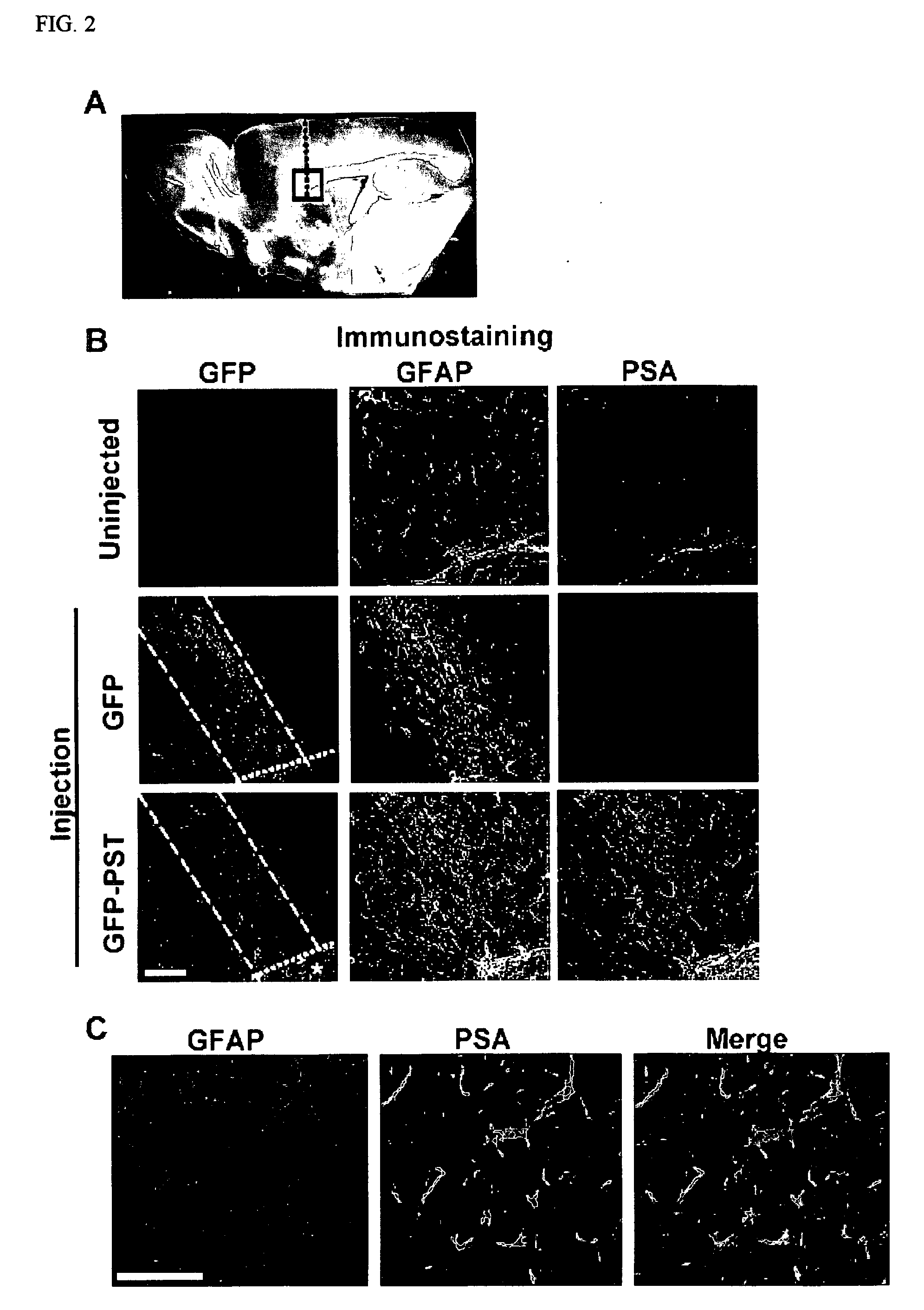Promotion of Cell Migration and Axon Regeneration in the Cns
a technology of axon regeneration and cell migration, applied in the field of promoting cell migration and axon regeneration in the cns, can solve the problems of poor prognosis for improvement and recovery, interruption of axon pathways, and limited repair ability of adult mammalian cns progenitor cells, etc., and achieve the effect of enhancing the migration of neural cells
- Summary
- Abstract
- Description
- Claims
- Application Information
AI Technical Summary
Benefits of technology
Problems solved by technology
Method used
Image
Examples
example 1
PSA Expression in COS-7 Cells after Transfection with the GFP-PST Plasmid
[0268] The GFP-PST fusion protein was inserted into the pCS-CG plasmid (FIG. 1A), and tested by co-transfection into COS-7 cells along with the NCAM plasmid. The Western blot shows a GFP-positive band at the expected molecular weight of 27 kDa in an extract of COS-7 cells transfected with GFP (control; FIG. 1B, left blot, left lane). Cells transfected with GFP-PST fusion protein yielded a band at 69 kDa (FIG. 1B, left blot, right lane), which is the expected molecular weight for the fusion protein. On the right (FIG. 1B, right blot), a Western blot specific for PSA shows a band at molecular weights over 150 kDa in NCAM / GFP-PST transfected COS-7 cells (center lane). These cells normally lack NCAM-PSA and are unable to express PSA after co-transfection with NCAM DNA only (control, left lane). The PSA band disappeared when the lysate was treated for 30 min with the PSA-specific endoneuraminidase N(PST+endo N, rig...
example 2
Viral-Infection and PST Expression in Astrocytes of Adult GFAP-TVA transgenic mice
[0270] GFAP-TVA transgenic animals express the TVA receptor exclusively in astrocytes, which allows selective infection of these cells by HIV (ALSV-A) lentiviral vectors. Accordingly, when brain slices from these animals were incubated with lentivirus carrying either the GFP-PST or the GFP construct, GFP expression (green) was restricted to only to astrocytes (red; GFAP positive) (FIG. 1D). After 6 days in culture, PSA appeared on the surface of the GFP-PST-infected astrocytes (data not shown).
[0271] After the in vitro studies, virus encoding GFP or GFP-PST was injected in vivo in the transgenic mice along a needle track extending through the cortex and corpus callosum (CC) to the SVZ (FIG. 2A). Immunohistological examination of the injected regions after 30 days revealed that the virus had selectively infected GFAP-expressing astrocytes (FIG. 2B), which have been reported to be found at lesioned are...
example 3
PSA Expression Enhances SVZ Progenitor Migration into the Corpus Callosum
[0272] To determine whether ectopic PSA expression would influence the migration of SVZ cells, experiments similar to those in Example 2 were carried out using the GFAP-TVA transgenic mice. The progenitor cells were pre-labeled by repetitive BrdU injections to identify cells undergoing DNA replication and cell proliferation, and were visualized by co-staining for BrdU and nestin (FIG. 3). Injection of the control GFP virus alone resulted in deviation of a small but significant number of SVZ progenitors into the CC as compared to an uninjected animal. (The induced expression of PSA in the control studies involves a needle track lesion, which can increase the presence of SVZ precursors in white matter (Goings et al., 2004)). Injection of the PST construct, on the other hand, increased the migration of progenitor cells into the CC by more than 4 times (FIGS. 3A and 3B; p<0.001). The injections did not induce glia...
PUM
| Property | Measurement | Unit |
|---|---|---|
| molecular weight | aaaaa | aaaaa |
| thick | aaaaa | aaaaa |
| dissociation constant | aaaaa | aaaaa |
Abstract
Description
Claims
Application Information
 Login to View More
Login to View More - R&D
- Intellectual Property
- Life Sciences
- Materials
- Tech Scout
- Unparalleled Data Quality
- Higher Quality Content
- 60% Fewer Hallucinations
Browse by: Latest US Patents, China's latest patents, Technical Efficacy Thesaurus, Application Domain, Technology Topic, Popular Technical Reports.
© 2025 PatSnap. All rights reserved.Legal|Privacy policy|Modern Slavery Act Transparency Statement|Sitemap|About US| Contact US: help@patsnap.com



